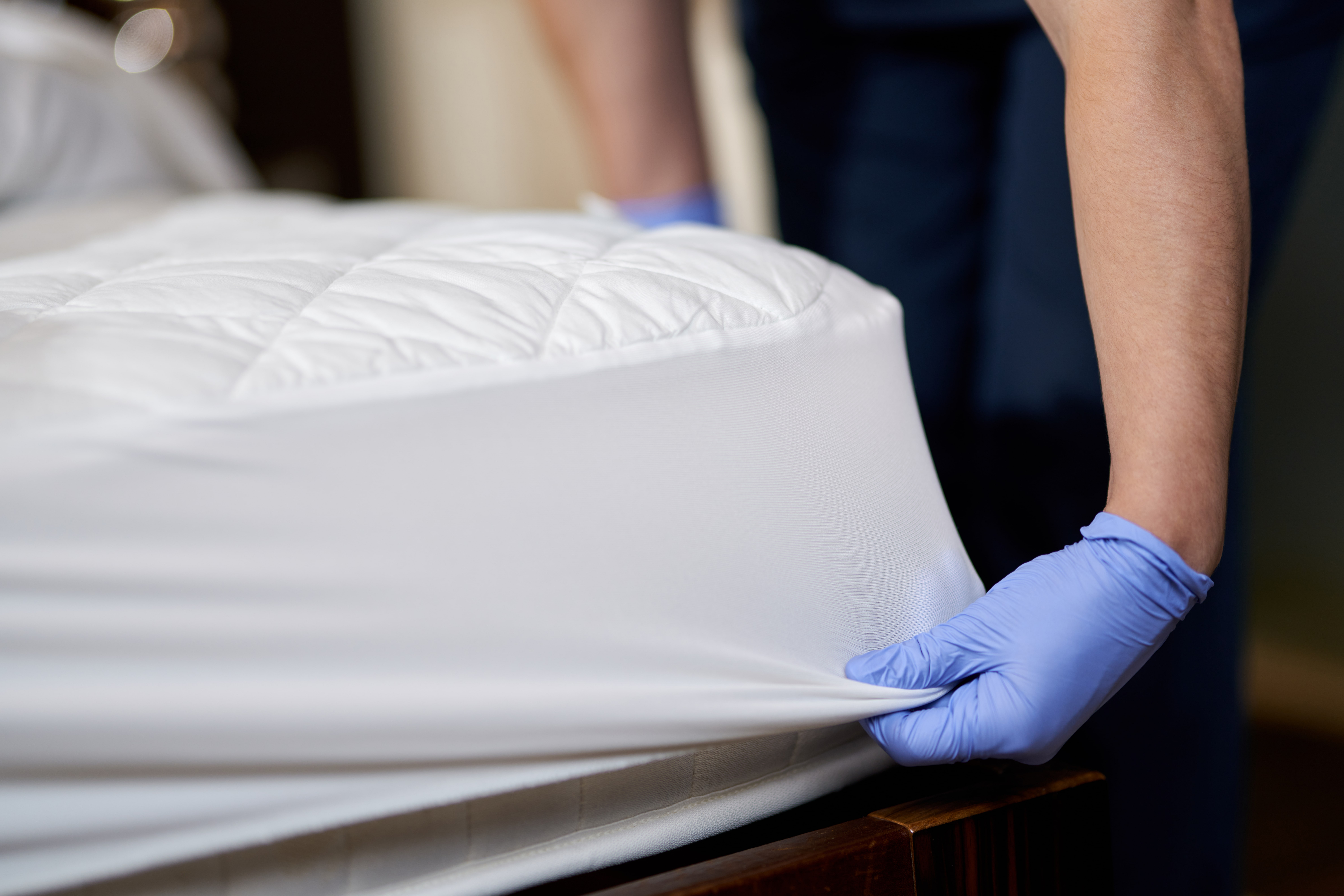Avoiding the “Buggy” Situation
Ah, the blissful sanctuary of our beloved beds – a place where dreams are woven and rejuvenation takes place. However, lurking in the shadows of sweet slumber lies an uninvited menace: bed bugs. These tiny blood-sucking insects have become quite the household nightmare in recent years.
Thankfully, we have bed bug repellents at our disposal to combat these pesky invaders. But before we delve into their efficacy, let’s first understand what bed bug repellents truly are.
Knowledge at Your Fingertips: Discover the answers to common questions about bed bugs in our informative article on Bed Bug FAQs. Expand your understanding and be better prepared to tackle any bed bug concerns.
Defining Bed Bug Repellents
Bed bug repellents can be described as products designed to deter bed bugs from coming into contact with your sleeping quarters. They come in various forms such as sprays, lotions, powders, or even devices emitting ultrasonic waves intended to repel these unwelcome guests. The primary purpose of a bed bug repellent is to create a barrier between you and these tenacious pests.
The Battle Against Infestation
Prevention is always better than cure when it comes to dealing with bed bug problems. Avoiding an infestation altogether saves you and your family from countless hours spent trying to get rid of bed bugs and the mental anguish that comes with it.
This is where using a reliable, bed bug spray repellent becomes crucial. The importance of preventing infestations cannot be overstated.
Bed bugs multiply rapidly and infestations can quickly escalate if not addressed promptly. These resilient creatures can survive for months without feeding and their minute size allows them to hide effortlessly amidst mattresses, upholstery cracks, or behind picture frames—making them incredibly difficult to spot.
Whether you’re sleeping at home or traveling abroad, having a trustworthy, bed bug spray or repellent on hand provides peace of mind by acting as a proactive defense against potential encounters with these bothersome critters. By utilizing repellents, you reduce the risk of bringing bed bugs into your sacred abode and can sleep soundly knowing you’ve taken the necessary precautions to protect yourself.
In the next section, we will explore the different types of bed bug repellents available today, ranging from chemical-based options to more natural alternatives. So, buckle up, and let’s dive deeper into this battle against bed bugs!
Understanding Bed Bugs and Their Behavior

An Unwanted Houseguest: The Bed Bug Invasion
Picture this: a quiet night in the comfort of your bed, ready to embrace the sweet slumber that awaits. But little do you know, there may be some uninvited guests lurking nearby.
Enter the world of bed bugs—tiny, elusive creatures that have been feeding on human blood for centuries. To effectively combat these pests and evaluate the efficacy of bed bug repellents, it is crucial to understand their feeding habits and life cycle.
A Midnight Feast: Bed Bugs’ Feeding Habits and Life Cycle
Bed bugs are nocturnal creatures with a voracious appetite for human blood. These pesky insects typically emerge from their hiding spots during the night to feast on unsuspecting victims who are blissfully unaware of their presence. While they prefer humans, these resilient pests can adapt to other warm-blooded hosts in the absence of humans.
The life cycle of a bed bug consists of multiple stages. It begins when tiny eggs are laid by female bed bugs in secluded areas such as cracks in furniture or seams of mattresses.
These eggs then hatch into nymphs eggs, which resemble miniature versions of adult bed bugs eggs. As they grow, nymphs molt several times before reaching maturity.
The Telltale Signs: Identifying a Bed Bug Infestation
Identifying a bed bug infestation is crucial for prompt action and effective treatment. One common sign of bed bug adults is waking up with itchy red welts or bite marks on exposed skin areas such as arms or legs after a night’s sleep.
However, it’s important to note that not everyone reacts to get rid of bed bugs or bug bites, making them stealthy intruders. Other indications include discovering rusty or reddish stains on bedding caused by crushed engorged bed bugs, small brown excrement spots on sheets or mattresses, and even a sweet musty odor emitted by severe infestations.
These signs provide valuable clues that your sanctuary may have been invaded by these bloodsucking pests. From their nocturnal feeding habits to their intricate life cycle, understanding bed bugs is the first step to effectively combating and preventing infestations.
Armed with this knowledge, we can now delve into the world of bed bug repellents and the burning question: do they actually work? Remember, it’s not just about getting rid of these little intruders; it’s about reclaiming your peace of mind and ensuring a good night’s rest free from unwanted visitors.
Types of Bed Bug Repellents
Chemical-based Repellents: Exploring Active Ingredients, Effectiveness, and Limitations

When it comes to combating bed bugs, chemical-based repellents have gained popularity due to their proven efficacy. Two commonly used active ingredients in such repellents are DEET (N,N-diethyl-meta-toluamide) and picaridin. DEET has long been recognized as a powerful insect repellent, widely used to ward off mosquitoes and other blood-sucking pests.
Picaridin, on the other hand, is a synthetic compound with similar capabilities to DEET but is often favored due to its reduced odor. These chemical-based repellents work by creating a barrier on the skin that deters bed bugs from landing and feeding.
While they can be effective in reducing bites when applied correctly, it’s important to note that they do not eliminate bed bug populations or prevent infestations entirely. Their effectiveness may vary depending on factors such as concentration levels of active ingredients and bed bug resistance.
Natural and Non-Chemical Repellents: Harnessing the Power of Essential Oils and Herbal Remedies

For those seeking more eco-friendly alternatives or concerned about exposing themselves or small children to chemicals, natural and non-chemical how do bed bug repellents work offer an enticing option. Essential oils like lavender and tea tree oil have gained popularity for their potential bed bug repelling properties.
These oils are thought to interfere with the pests’ sensory perception, making them reluctant to approach treated areas. Additionally, herbal remedies such plant oils such as neem oil and diatomaceous earth have shown promise in deterring bed bugs.
Neem oil contains compounds that disrupt the pests’ feeding patterns while diatomaceous earth acts as a physical barrier that absorbs moisture from insects’ bodies, leading them to dehydrate and die. However, it’s crucial to approach natural remedies with caution as their efficacy may vary, and some products may have potential side effects.
Essential oils should always be diluted properly since using them undiluted on the skin can cause irritation. Similarly, while diatomaceous earth is generally safe for humans and pets, inhaling large amounts of it can irritate the respiratory system.
Knowing the different types of bed bug repellents available empowers individuals in their battle against these persistent pests. Chemical-based repellents like those containing DEET or picaridin can provide effective temporary relief from bites but do not eradicate infestations.
Natural and non-chemical alternatives offer a more eco-friendly option, utilizing essential oils and herbal remedies to deter and kill insects and bed bugs naturally; however, their efficacy and potential side effects warrant careful consideration when choosing such products. To effectively combat bed bug problems and prevent infestations altogether, a comprehensive approach that includes both repellents and other effective treatments is crucial.
Do Bed Bug Repellents Actually Work?

Scientific Studies on the Effectiveness of Repellents
When it comes to bed bug repellents, many people wonder if these products actually do what they claim. To shed light on this question, numerous scientific studies have been conducted to determine the efficacy of various repellents. These studies provide valuable insights into the effectiveness of both chemical-based and natural remedies.
Research Findings on Chemical-based Repellents
Chemical-based bed bug repellents, often containing active ingredients like DEET or picaridin, have been extensively studied. Research shows that these repellents can indeed provide a certain level of protection against bed bug bites. However, their effectiveness is influenced by factors such as concentration and application technique.
For instance, a study published in the Journal of Medical Entomology found that pyrethroid sprays containing specific concentrations were effective in repelling bed bugs for up to two weeks when applied directly to infested areas. These findings suggest that chemical-based repellents can be useful tools in controlling bed bug problems when used correctly.
Studies Evaluating Natural Remedies
In recent years, there has been increasing interest in natural remedies as alternatives to chemical-based treatments. Essential oils such as lavender and tea tree oil have gained popularity for their potential repellent properties against bed bugs. Several studies have investigated the effectiveness of essential oils against bed bugs and found promising results.
For example, research published in BMC Complementary Medicine and Therapies revealed that lavender oil displayed significant repellent effects against bed bugs during laboratory experiments. However, it is important to note that while natural remedies may show promise in repelling bed bugs under controlled conditions, their efficacy might be limited when applied in real-world situations with high infestation levels or diverse bed bug hiding places.
Factors Influencing the Efficacy of Bed Bug Repellents
While repellents can offer some protection against bed bugs, their efficacy can be influenced by various factors. Two key factors that impact the effectiveness of bed bug repellents are environmental conditions and bed bug resistance.
Environmental Conditions: Temperature and Humidity
Bed bugs thrive in specific environmental conditions. They prefer temperatures between 70-80°F (21-27°C) and humidity levels around 70%. However, studies have shown that extreme temperatures can affect their behavior and response to repellents.
For instance, a study published in PLOS ONE found that at lower temperatures (below 64°F/18°C), the efficacy of pyrethroid-based repellents decreased significantly. Conversely, higher temperatures (above 99°F/37°C) were found to enhance the effectiveness of certain chemical-based repellents.
Bed Bug Resistance to Certain Chemicals
Over time, bed bugs have developed resistance to some commonly used chemicals in pest control. This resistance can reduce the effectiveness of certain repellent products. A study conducted by researchers at Purdue University discovered widespread resistance among bed bug populations to pyrethroids – a common class of insecticides used in many commercial products.
This resistance highlights the need for alternative approaches and integrated pest management strategies to combat bed bug infestations effectively. Scientific studies demonstrate that both chemical-based and natural remedies have shown potential as bed bug repellents under controlled conditions.
However, their effectiveness can vary depending on environmental factors and the presence of resistant bed bug populations. It is crucial to consider these factors when selecting a repellent and combine its use with other effective methods such as regular inspections, vacuuming, sealing cracks or crevices, using box spring encasements, or seeking professional assistance from a reputable pest control company if necessary.
Practical Tips for Using Bed Bug Repellents Effectively
Proper Application Techniques for Different Types of Repellents
When it comes to spraying and using bed bug repellents effectively, understanding the proper application techniques is crucial. For chemical-based repellents, always read and follow the label directions carefully. Shake the empty spray bottle well before use and spray a light mist evenly on surfaces where bed bugs may hide or travel.
Pay close attention to areas such as mattresses, box springs, and bedding. It’s important to note that most chemical repellents provide residual protection, so reapply according to the instructions.
For natural and non-chemical repellents like essential oils or herbal remedies, the application process may differ slightly. These products often come in spray bottles or can be mixed with water before use in spray can.
Ensure that you dilute them properly as per the instructions provided. Apply a fine mist of the solution on surfaces where bed bugs are likely to be present, such as crevices, cracks, or along baseboards.
Preventive Measures to Complement the Use of Repellent Products
While using bed bug repellents is a helpful step in preventing infestations, it’s important to complement these efforts with additional preventive measures. One crucial aspect is maintaining cleanliness and good hygiene practices.
Regularly vacuum your bedding, mattress seams, carpets, furniture and other potential hiding spots for bed bugs. After vacuuming these areas thoroughly, immediately dispose of the vacuum bag in sealed plastic bags outside your home.
Another preventive measure is washing fabrics at high temperatures whenever possible. Bedding materials should be washed in hot water (around 120°F) followed by drying on high heat settings for at least 30 minutes to eliminate any potential bed bug eggs or adults that might have hitched a ride on your textiles.
Additionally, consider using bed frames or mattress encasements specifically designed for bed bug protection. These bed frame or encasements create a barrier that prevents bed bugs from infesting your mattress or box spring.
Make sure to choose mattress encasements labeled as bed bug-proof and follow the manufacturer’s instructions for installation. To further enhance your preventive efforts, you can also use dryer sheets in your laundry routine.
The strong odor produced by dryer sheets is believed to repel and kill bed bugs. Place a few dryer sheets in your drawers, closets, and suitcases to deter these unwelcome pests from making themselves at home.
Remember, when it comes to eliminating bed bugs or preventing infestations, a multi-faceted approach is usually the most effective. Bed bug repellents play a role in keeping these pesky creatures at bay, but they work best when combined with other proven and eco-friendly treatments and preventive measures suited for your specific circumstances.
Alternative Approaches to Preventing Bed Bug Infestations
The Power of Professional Pest Control Services

When it comes to dealing with the persistent pests known as the bed bug eggs and dead bed bugs themselves, sometimes it’s best to leave the job to the experts. Professional pest control services can be a game-changer in eradicating bed bug infestations effectively and efficiently.
These trained professionals have the knowledge, experience, and specialized tools necessary to tackle even the most severe cases. A reputable pest management professional will conduct a thorough inspection of your home, including those hard-to-reach areas where bed bugs tend to hide, such as cracks in furniture or behind wallpaper.
Once identified, they will develop a customized treatment plan tailored specifically for your situation. This may involve using a combination of techniques like vacuuming, heat treatments, or targeted insecticide application in infested areas.
While professional services come at a cost, think of it as an investment in your peace of mind and the well-being of your family. With their expertise and comprehensive approach to controlling bed bugs, they can offer long-lasting relief from these relentless pests.
Educating Yourself: The First Line of Defense
Prevention is always better than dealing with a full-blown infestation. Educating yourself about travel precautions is essential because bed bugs are notorious hitchhikers that can easily make their way into your home through luggage or other items you bring back from trips. Before booking accommodations during your travels, take some time to research hotels or rentals for any reported bed bug issues.
Read reviews from previous guests who may have encountered these unwelcome critters during their stay. It’s also a good idea to inspect hotel rooms upon arrival by checking mattresses, headboards, and upholstered furniture for signs of an infestation (such as dark spots or shed skins).
To further protect yourself while on the go, consider using bed bug spray or insect repellents specifically designed for these and other pests too. These products are often eco-friendly and safe to use around humans and pets.
Spot treating your luggage before and after each trip can help prevent bed bugs from hitching a ride back home with you. By educating yourself about the habits of bed bugs and taking necessary precautions, you can reduce the likelihood of a costly and stressful infestation in your own home.
Making Informed Decisions about Bed Bug Repellent Use
In the quest to prevent bed bug infestations, using bed bug repellents is just one piece of the puzzle. While repellents can be useful tools, it’s important to remember that they are not foolproof solutions.
Their effectiveness may vary depending on factors such as the specific product used, application method, environmental conditions, and even potential resistance of bed bugs to certain chemicals. Exploring alternative approaches like hiring professional pest control services offers a comprehensive solution by addressing the root cause of infestations rather than merely repelling bed bugs.
The expertise and specialized techniques employed by professionals can provide long-lasting relief from these persistent pests. Moreover, education plays a crucial role in preventing future infestations.
Becoming familiar with travel precautions allows you to be proactive in avoiding encounters with bed bugs during your trips. Taking steps such as inspecting hotel rooms before settling in or using travel-friendly insect repellents helps safeguard against bringing these unwanted guests back home with you.
While it’s essential to stay informed about various prevention methods like using repellents, it’s equally important to consider holistic approaches that encompass professional expertise and personal vigilance. By combining these strategies, you’ll empower yourself to tackle potential bed bug issues effectively while enjoying peace of mind in your own sanctuary – free from those pesky intruders!
Exploring the Options: A Wise Approach to Choosing Bed Bug Repellents
When it comes to protecting yourself from pesky bed bugs, knowledge is power. By understanding the different types of bed bug repellents available and their limitations, you can make informed decisions about which ones to use. Chemical-based repellents containing active ingredients like DEET or picaridin offer a reliable option for repelling bed bugs, but they may come with certain drawbacks.
On the other hand, natural remedies such as essential oils or herbal solutions can be an attractive alternative for those seeking non-chemical options. Consider your personal preferences, health considerations, and the specific circumstances in which you expect to encounter bed bugs before making your choice.
Application Techniques: Maximizing the Effectiveness of Bed Bug Repellents
To ensure the best possible outcome in using bed bug repellents, it is crucial to apply them correctly. Whether using chemical-based products or natural remedies, carefully follow the product label instructions for dosage and application methods. Thoroughly spray all potentially infested areas such as mattresses, box springs, upholstered furniture, and cracks and crevices where bed bugs tend to hide.
Don’t forget seemingly hard-to-reach places like behind picture frames or electrical outlets. By paying attention to proper application techniques, you increase your chances of repelling bed bugs effectively.
Complementary Measures: Enhancing Your Defense against Bed Bugs

While bed bug repellents can be a valuable tool in preventing infestations, it’s essential to remember that they should not be relied upon as the sole solution to bed bug problem. Consider adopting additional preventive measures such as inspecting hotel rooms or second-hand furniture kill bed bugs before use, washing clothes at high temperatures after suspected exposure to bed bugs, and regularly vacuuming your home. By combining the use of repellents with these complementary strategies, you create multiple barriers to repel and eliminate bed bugs effectively.
Optimism in Your Battle: Taking Control and Eradicating Bed Bugs
Although bed bugs can be a nuisance, it’s important to approach the issue with optimism. With proper knowledge, preventive measures, and the right choice of bed bug repellents, you can take control of your environment and minimize the risk of infestation.
Remember that if an infestation occurs despite your best efforts, seeking professional assistance from a pest control company experienced in handling bed bug treatment is wise. Stay informed about common myths and misconceptions surrounding the bed bug control in bugs to separate fact from fiction and professional help overcome any unnecessary anxiety associated with these unwanted critters.
While no single solution guarantees complete protection against bed bugs, using repellents can be an effective part of your defense strategy against these persistent pests. By understanding the different types of repellents available and their application techniques, making informed choices becomes easier.
Complementing their use with other preventive measures further strengthens your defense. With a proactive mindset and optimism in overcoming any challenges that may arise on this journey, you can effectively repel bed bugs and enjoy a peaceful night’s sleep without worrying about unwelcome visitors.
Combat bed bugs with D-Termination: Las Vegas’ top-tier pest control service!

Are you currently grappling with a bed bug infestation in Las Vegas? Look no further, as D-Termination is here to offer assistance. Our expert team specializes in eliminating bed bug infestations and restoring comfort to your living space. Bid farewell to bed bugs and opt for D-Termination’s effective pest control today!
To book your bed bug control service and reclaim your space from these persistent pests, feel free to contact us at 702-919-6310 or visit dtermination.com.
Frequently Asked Questions:
Bed bugs can be repelled using various methods, including the use of essential oils like lavender or tea tree oil, diatomaceous earth, or bed bug mattress encasements.
The most effective bed bug treatment often involves a combination of professional pest control services, such as heat treatments or insecticide applications, coupled with thorough cleaning and decluttering.
Permanently getting rid of bed bugs in your house requires a comprehensive approach, including thorough cleaning, vacuuming, laundering infested items, sealing cracks, and potentially seeking professional assistance.
To prevent bed bugs from biting you, use mattress and pillow encasements, avoid bringing used furniture or items of unknown origin into your home, and regularly inspect your sleeping area for signs of infestation.
If you found this article enjoyable, you might also find the following related content worth exploring:
Dispelling the Veil: Debunking Common Bed Bug Myths
Exterminating Bed Bugs: Unleashing the Power of Nature’s Remedies







